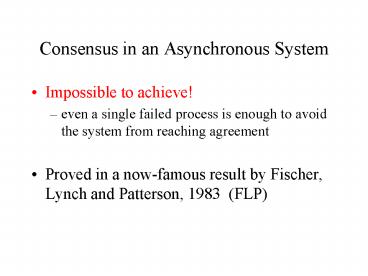Consensus in an Asynchronous System PowerPoint PPT Presentation
1 / 22
Title: Consensus in an Asynchronous System
1
Consensus in an Asynchronous System
- Impossible to achieve!
- even a single failed process is enough to avoid
the system from reaching agreement - Proved in a now-famous result by Fischer, Lynch
and Patterson, 1983 (FLP)
2
Recall
- Each process p has a state
- program counter, registers, stack, local
variables - input register xp initially either 0 or 1
- output register yp initially b
- Consensus Problem design a protocol so that
either - all processes set their output variables to 0
- Or all processes set their output variables to 1
3
p
p
send(p,m)
receive(p) may return null
Global Message Buffer
Network
4
- State of a process
- Configuration collection of states, one for each
process and state of the global buffer - Each Event
- receipt of a message by a process (say p)
- processing of message
- sending out of all necessary messages by p
- Schedule sequence of events
5
C
Configuration C
C
Event e(p,m)
Schedule s(e,e)
C
C
Event e(p,m)
C
Equivalent
6
Lemma 1
Schedules are commutative
C
s2
Schedule s1
C
s1 and s2 involve disjoint sets of receiving
processes
Schedule s2
s1
C
7
Easier Consensus Problem
- Easier Consensus Problem some process eventually
sets yp to be 0 or 1 - Only one process crashes were free to choose
which one - Consensus Protocol correct if
- Any accessible config. (config. reachable from an
initial config.) does not have gt 1 decision value - For v in 0,1, some accessible config. has value
v - avoids trivial solution to the consensus problem
8
- Let config. C have a set of decision values V
reachable from it - If V 2, config. C is bivalent
- If V 1, config. C is 0-valent or 1-valent, as
is the case - Bivalent means outcome is unpredictable
9
What well Show
- There exists an initial configuration that is
bivalent - Starting from a bivalent config., there is always
another bivalent config. that is reachable
10
Lemma 2
- Some initial configuration is bivalent
- Suppose all initial configurations were either
0-valent or 1-valent. - Place all configurations side-by-side, where
adjacent configurations - differ in initial xp value for exactly one
process.
1 1 0 1 0
1
- There is some adjacent pair of 1-valent and
0-valent configs.
11
Lemma 2
- Some initial configuration is bivalent
- There is some adjacent pair of 1-valent and
0-valent configs. - Let the process p that has a different state
across these two configs. be - the process that has crashed (silent
throughout)
- Both initial configs. will lead to the same
config. for the same sequence of events - One of these initial configs. must be bivalent to
allow for a failure
1 1 0 1 0
1
12
What well Show
- There exists an initial configuration that is
bivalent - Starting from a bivalent config., there is always
another bivalent config. that is reachable
13
Lemma 3
- Starting from a bivalent config., there is always
another bivalent config. that is reachable
14
Lemma 3
A bivalent initial config.
let e(p,m) be an applicable event to the
initial config.
Let C be the set of configs. reachable without
applying e
15
Lemma 3
A bivalent initial config.
let e(p,m) be an applicable event to the
initial config.
Let C be the set of configs. reachable without
applying e
e e e e e
Let D be the set of configs. obtained by
applying e to a config. in C
16
Lemma 3
17
- i-valent config Ei reachable
- from C exists (because C is
- bivalent)
- If Ei in C, then Fi e(Ei)
- Else e was applied reaching EiEither way there
exists Fi in D - for i0 and 1 both
- Claim. D contains a bivalent config.
- Proof. By contradiction. gt assume there is no
bivalent config in D - There are adjacent configs. C0 and C1 in C such
that - C1 C0 followed by e
- and
- e(p,m)
- D0C0 foll. by e(p,m)
- D1C1 foll. by e(p,m)
- D0 is 0-valent, D1 is 1-valent
- (why?)
18
C0
- Proof. (contd.)
- Case I p is not p
- Case II p same as p
e
e
D0
C1
e
e
D1
Why? (Lemma 1) But D0 is then bivalent!
19
C0
- Proof. (contd.)
- Case I p is not p
- Case II p same as p
e
e
C1
e
D0
sch. s
D1
sch. s
sch. s
A
e
(e,e)
E1
E0
- sch. s
- finite
- deciding run from C0
- p takes no steps
But A is then bivalent!
20
Lemma 3
Starting from a bivalent config., there is always
another bivalent config. that is reachable
21
Putting it all Together
- Lemma 2 There exists an initial configuration
that is bivalent - Lemma 3 Starting from a bivalent config., there
is always another bivalent config. that is
reachable - Theorem (Impossibility of Consensus) There is
always a run of events in an asynchronous
distributed system such that the group of
processes never reach consensus
22
Summary
- Consensus Problem
- agreement in distributed systems
- Solution exists in synchronous system model
(e.g., supercomputer) - Impossible to solve in an asynchronous system
- Key idea with one process failure, there are
always sequences of events for the system to
decide any which way - FLP impossibility proof

